Brazil Travel Tips, Tricks and Information
Rio de Janeiro
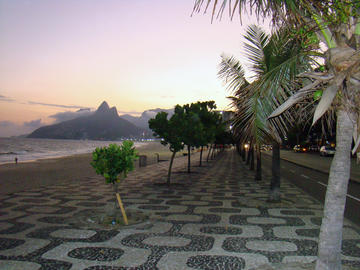 Rio de Janeiro is the second largest city in Brazil, and is the main tourist destination for South America. When people think of Brazil, they often conjure up images of this city, with its famous beaches, land marks, and celebrations. The most famous beaches which everyone should see at least once during their lifetime, include Copacabana Beach, Ipanema Beach and Leblon Beach. While the beaches draw enormous crowds, the city is also known for its famous carnival celebrations, which take place each year for five days during February. Rio de Janerio is also know for several famous landmarks including the giant statue of Christ the Redeemer atop Corcovado mountain, and the Sugar Loaf which can be seen from many hotel rooms. A vibrant nightlife, with many well known clubs including Baronneti, Hideaway, Icy, and Nuth give those looking to continue partying well into the night a good selection to choose from, while all being fairly local to the main grouping of tourist hotels along the beaches. Finally, the 2016 Summer Olympics will take place in Rio, which will be the first South American city to host the event! The main airport is Rio's Galeão International Airport (GIG) which handles direct international flights from around the world.
Rio de Janeiro is the second largest city in Brazil, and is the main tourist destination for South America. When people think of Brazil, they often conjure up images of this city, with its famous beaches, land marks, and celebrations. The most famous beaches which everyone should see at least once during their lifetime, include Copacabana Beach, Ipanema Beach and Leblon Beach. While the beaches draw enormous crowds, the city is also known for its famous carnival celebrations, which take place each year for five days during February. Rio de Janerio is also know for several famous landmarks including the giant statue of Christ the Redeemer atop Corcovado mountain, and the Sugar Loaf which can be seen from many hotel rooms. A vibrant nightlife, with many well known clubs including Baronneti, Hideaway, Icy, and Nuth give those looking to continue partying well into the night a good selection to choose from, while all being fairly local to the main grouping of tourist hotels along the beaches. Finally, the 2016 Summer Olympics will take place in Rio, which will be the first South American city to host the event! The main airport is Rio's Galeão International Airport (GIG) which handles direct international flights from around the world.
Natal
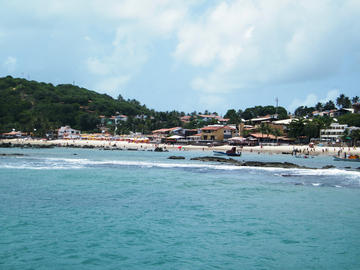 Natal is a hot tropical climate only six degrees from the equator, with many fine white sandy beaches, lined with coconut and palm trees running down the beautiful beaches here and with large dunes just beyond the beaches. It's a tropical paradise, and also the safest capital city in Brazil, with a population of around 1.2M people. During the summer months it normally reaches above 85F with water temperatures around 80F. Tourism is the most important industry here, and the beautiful beaches are a great attraction to bring in those tourists. Natal hotels are primarily located along these great beaches, so be ready to bath, or swim in these warm ocean waters, or simply take a stroll down the endless beaches on a daily basis. Dune buggy tours are one of the most common activity offered to every tourist, with a large number of options to choose from, these are extremely fun and well worth it. You wil be asked if you want with emotion or without, but we would definitely recommend being prepared for emotion either way! There are several other unique tourist attracts in Natal, including the largest cashew tree in the world, and an old dutch fort dating back hundreds of years. The main airport is Augusto Severo International Airport (NAT).
Natal is a hot tropical climate only six degrees from the equator, with many fine white sandy beaches, lined with coconut and palm trees running down the beautiful beaches here and with large dunes just beyond the beaches. It's a tropical paradise, and also the safest capital city in Brazil, with a population of around 1.2M people. During the summer months it normally reaches above 85F with water temperatures around 80F. Tourism is the most important industry here, and the beautiful beaches are a great attraction to bring in those tourists. Natal hotels are primarily located along these great beaches, so be ready to bath, or swim in these warm ocean waters, or simply take a stroll down the endless beaches on a daily basis. Dune buggy tours are one of the most common activity offered to every tourist, with a large number of options to choose from, these are extremely fun and well worth it. You wil be asked if you want with emotion or without, but we would definitely recommend being prepared for emotion either way! There are several other unique tourist attracts in Natal, including the largest cashew tree in the world, and an old dutch fort dating back hundreds of years. The main airport is Augusto Severo International Airport (NAT).
Florianópolis
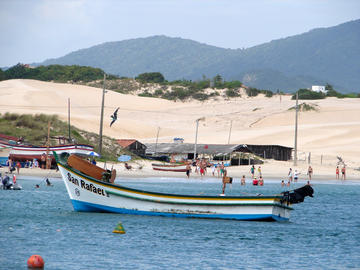 Florianópolis is in southern Brazil, situated on the Island of Santa Catarina with a population of just over 800,000. Tourism is one the main industries in Florianópolis, with many people coming from around the world to this little city. The main attraction is the huge number of beaches, and the quality of those beaches, especially the number of beaches suitable for surfing. Beaches such as Joaquina Beach were discovered in the 1970's by surfers and today play a major role in the sport. The ASP World Tour, Association of Surfing Professionals uses Florianópolis as their main location for classifying 50 competitors, both professional and amateur. Another major attraction is the Hercílio Luz Bridge, which was the first bridge to help unite the city with the mainland. Today it stands as a historical monument. Florianópolis also ranks very highly on every development measures from literacy to electrification. The state has spent a lot of money on education and programs to help eliminate poverty and it has paid off with dramatic effects. The main airport here is Hercílio Luz International Airport (FLN).
Florianópolis is in southern Brazil, situated on the Island of Santa Catarina with a population of just over 800,000. Tourism is one the main industries in Florianópolis, with many people coming from around the world to this little city. The main attraction is the huge number of beaches, and the quality of those beaches, especially the number of beaches suitable for surfing. Beaches such as Joaquina Beach were discovered in the 1970's by surfers and today play a major role in the sport. The ASP World Tour, Association of Surfing Professionals uses Florianópolis as their main location for classifying 50 competitors, both professional and amateur. Another major attraction is the Hercílio Luz Bridge, which was the first bridge to help unite the city with the mainland. Today it stands as a historical monument. Florianópolis also ranks very highly on every development measures from literacy to electrification. The state has spent a lot of money on education and programs to help eliminate poverty and it has paid off with dramatic effects. The main airport here is Hercílio Luz International Airport (FLN).
São Paulo
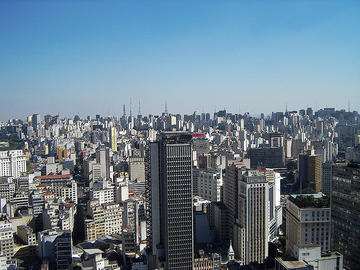 São Paulo is an absolutely massive city, with nearly 20 million people in the metropolitan area! It the largest city in South America, and the 7th largest city in the world. Many international flights use Sao Paulo as their hub, and where most people will see the Brazilian customs people. Sao Paulo is also the richest city in Brazil and known for its land marks, museums and parks, including such attractions as the Museu Paulista do Ipiranga, the gothic Metropolitan Sé Cathedral, and the very famous São Paulo Museum of Art, with a collection of over 8000 pieces of artwork. The city boasts the largest shopping center in Latin America, the Centro Comercial Leste Aricanduva and provides some of the best shopping in Latin America. The city itself is inland and has none of the famous beaches that Brazil is famous for, but this charming city has a lot of history, culture and cuisine that makes up for it. One problem that plagues most cities around the world is billboard advertising, advertising, and huge building signage. The Mayor made billboards illegal and limited store signage, making the city oddly void of major advertising. The effect is subtle to those who don't know about the law, as if something is missing but you can't put your finger on it. The majority of the people reveal in their new clean city, which now helps highlight the many different architectures found around the city. The international airport is São Paulo-Guarulhos International Airport (GRU).
São Paulo is an absolutely massive city, with nearly 20 million people in the metropolitan area! It the largest city in South America, and the 7th largest city in the world. Many international flights use Sao Paulo as their hub, and where most people will see the Brazilian customs people. Sao Paulo is also the richest city in Brazil and known for its land marks, museums and parks, including such attractions as the Museu Paulista do Ipiranga, the gothic Metropolitan Sé Cathedral, and the very famous São Paulo Museum of Art, with a collection of over 8000 pieces of artwork. The city boasts the largest shopping center in Latin America, the Centro Comercial Leste Aricanduva and provides some of the best shopping in Latin America. The city itself is inland and has none of the famous beaches that Brazil is famous for, but this charming city has a lot of history, culture and cuisine that makes up for it. One problem that plagues most cities around the world is billboard advertising, advertising, and huge building signage. The Mayor made billboards illegal and limited store signage, making the city oddly void of major advertising. The effect is subtle to those who don't know about the law, as if something is missing but you can't put your finger on it. The majority of the people reveal in their new clean city, which now helps highlight the many different architectures found around the city. The international airport is São Paulo-Guarulhos International Airport (GRU).
Curitiba
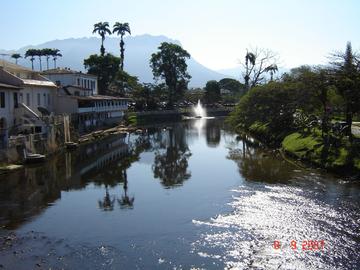 Curitiba is considered to be the best place to live in Brazil with a population of 3.2M people, it is the largest city in Southern Brazil. Summer temperatures range from 70F to 90F, neither getting too cold or too hot for most people. The population is primarily Brazilians with an European descent, which is more common in Southern Brazil. The city is known for it's many green parks, forests and open public spaces, and has won many awards for its urban planning. While the city lacks any near by beaches that Brazil is famous for, it makes up for it in natural beauty, parks and recreational activities. Curitiba is considered one of the best examples of urban planning in the world, with many great parks through out the city center, including the famous Barigui Park, one of the cities most cherished parks and also most visited. In 2007, Curitiba came in 3rd place for top "15 Green Cities" in the world, and is generally considered the ecological capital of Brazil. Major attractions include Opera de Arame, the Iguaçu Park Zoo and the Jardim Botanico gardens. The main airport is Afonso Pena International Airport (CWB).
Curitiba is considered to be the best place to live in Brazil with a population of 3.2M people, it is the largest city in Southern Brazil. Summer temperatures range from 70F to 90F, neither getting too cold or too hot for most people. The population is primarily Brazilians with an European descent, which is more common in Southern Brazil. The city is known for it's many green parks, forests and open public spaces, and has won many awards for its urban planning. While the city lacks any near by beaches that Brazil is famous for, it makes up for it in natural beauty, parks and recreational activities. Curitiba is considered one of the best examples of urban planning in the world, with many great parks through out the city center, including the famous Barigui Park, one of the cities most cherished parks and also most visited. In 2007, Curitiba came in 3rd place for top "15 Green Cities" in the world, and is generally considered the ecological capital of Brazil. Major attractions include Opera de Arame, the Iguaçu Park Zoo and the Jardim Botanico gardens. The main airport is Afonso Pena International Airport (CWB).
Porto Alegre
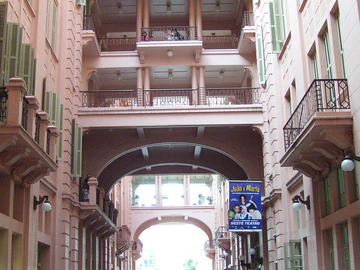 Porto Alegre translates directly to "Happy Harbor" and is the eleventh most populous city in Brazil, with more than 4M people and is also the capital city of the Southern most state of Rio Grande do Sul. The harbor is actually a giant freshwater lagoon navigable by even the largest of ships. Like many harbor based cities, it is wealthy and one of the most wealthy cities in Brazil. It has hosted the World Social Forum. It is subtropical zone, with summer temperatures often rising above 90F. The city is located at the junction of five rivers, and is one of the chief industrial and commercial centers in Brazil. One of the most famous foods of Brazil, the churrasco (slow-grilled and -roasted meat), originated in Rio Grande do Sul. The traditional beverage is the "erva mate" which is hot tea like beverage that is shared among a group of people. Watch out, it can contain contain 3-5 times the caffeine of a cup of coffee! The main airport is Salgado Filho International Airport (POA).
Porto Alegre translates directly to "Happy Harbor" and is the eleventh most populous city in Brazil, with more than 4M people and is also the capital city of the Southern most state of Rio Grande do Sul. The harbor is actually a giant freshwater lagoon navigable by even the largest of ships. Like many harbor based cities, it is wealthy and one of the most wealthy cities in Brazil. It has hosted the World Social Forum. It is subtropical zone, with summer temperatures often rising above 90F. The city is located at the junction of five rivers, and is one of the chief industrial and commercial centers in Brazil. One of the most famous foods of Brazil, the churrasco (slow-grilled and -roasted meat), originated in Rio Grande do Sul. The traditional beverage is the "erva mate" which is hot tea like beverage that is shared among a group of people. Watch out, it can contain contain 3-5 times the caffeine of a cup of coffee! The main airport is Salgado Filho International Airport (POA).
Gramado
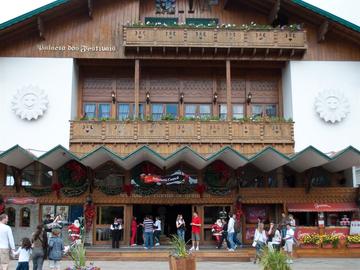 Gramado is a small touristic town about a two hour drive north of Porto Alegre. It is the thrid most sought after destination by Brazilians when planning their vacations. It's a hidden gem in the mountains of Brazil. The population is mostly of German and Italian descent and has major European influences in the culture, food, and buildings. Gramado also hosts the yearly Festival de Cinema, the most important film awards ceremony in South America. Gramado relies heavily on tourism, so it's always dressed up for an event. During Christmas, the Natal Luz festival brings out the best in Christmas decorations, flowers, lights, and music. The mountains provide a cooler climate during the summer temperatures found in most of the surrounding areas and has been known to have some snow fall, but this is a fairly rare event! The city is gorgeous in the summer time, and completely decorated for Christmas, which falls during summer time in Brazil.
Gramado is a small touristic town about a two hour drive north of Porto Alegre. It is the thrid most sought after destination by Brazilians when planning their vacations. It's a hidden gem in the mountains of Brazil. The population is mostly of German and Italian descent and has major European influences in the culture, food, and buildings. Gramado also hosts the yearly Festival de Cinema, the most important film awards ceremony in South America. Gramado relies heavily on tourism, so it's always dressed up for an event. During Christmas, the Natal Luz festival brings out the best in Christmas decorations, flowers, lights, and music. The mountains provide a cooler climate during the summer temperatures found in most of the surrounding areas and has been known to have some snow fall, but this is a fairly rare event! The city is gorgeous in the summer time, and completely decorated for Christmas, which falls during summer time in Brazil.
Brasília
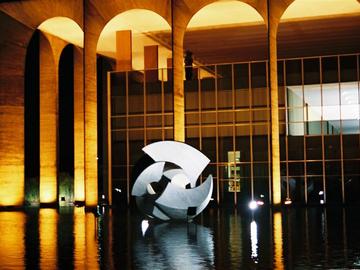 Brasília is the capital of Brazil, with a population of around 2.5M people. The city is actually in central Brazil, where it is land locked. You won't find any of the spectacular Brazilian beaches here, but there is still a lot to do. The city hosts many official government events, and many embassies are found here, all of whom want to impress, and therefore some of the best food, music and theater is found here. If you've got children or love nature, check out the Fundacao Zoo or for a bit more adventure the Maquiné Cave. The service sector here is fantastic, with plenty of high end hotels for those seeking out luxury accommodations. The city was planned and developed in 1956, with the purpose of becoming the capital of Brazil. All of the official government buildings are present within the city, and easily accessible to any who wish to tour the area. Historical the city is far younger than most in Brazil, so it misses out on some of the historic buildings but makes up for it in it's more modern architecture which is equally interesting. The city is a major airport hub for all of Brazil, and the main airport is Brasília International Airport (BSB).
Brasília is the capital of Brazil, with a population of around 2.5M people. The city is actually in central Brazil, where it is land locked. You won't find any of the spectacular Brazilian beaches here, but there is still a lot to do. The city hosts many official government events, and many embassies are found here, all of whom want to impress, and therefore some of the best food, music and theater is found here. If you've got children or love nature, check out the Fundacao Zoo or for a bit more adventure the Maquiné Cave. The service sector here is fantastic, with plenty of high end hotels for those seeking out luxury accommodations. The city was planned and developed in 1956, with the purpose of becoming the capital of Brazil. All of the official government buildings are present within the city, and easily accessible to any who wish to tour the area. Historical the city is far younger than most in Brazil, so it misses out on some of the historic buildings but makes up for it in it's more modern architecture which is equally interesting. The city is a major airport hub for all of Brazil, and the main airport is Brasília International Airport (BSB).
Manaus
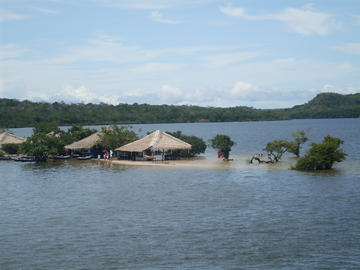 Manaus is the second largest city in Northern Brazil with a population of two million. It is situated on the Amazon river where the Negro and Solimões rivers meet. It is a popular ecotourism destination, as it offers great access to both the Amazon forest, and the Amazon river. Due to it's location in the Amazon rain forest, tourists can easily find boats and land tours into the surrounding jungle areas where they'll come into contact with many of the local plants and wild animals. Beaches are formed when the water levels in the Amazon river drop, and are usually accessible only by boat. One popular tourist destination is to go visit the meeting of the Negro river with the Solimões river. The meeting creates an unusual site as the black water from the Negro mixes with the muddy water of the Solimões, but doesn't actually combined for several miles creating a distinctive split. The main airport is Eduardo Gomes International Airport (MAO).
Manaus is the second largest city in Northern Brazil with a population of two million. It is situated on the Amazon river where the Negro and Solimões rivers meet. It is a popular ecotourism destination, as it offers great access to both the Amazon forest, and the Amazon river. Due to it's location in the Amazon rain forest, tourists can easily find boats and land tours into the surrounding jungle areas where they'll come into contact with many of the local plants and wild animals. Beaches are formed when the water levels in the Amazon river drop, and are usually accessible only by boat. One popular tourist destination is to go visit the meeting of the Negro river with the Solimões river. The meeting creates an unusual site as the black water from the Negro mixes with the muddy water of the Solimões, but doesn't actually combined for several miles creating a distinctive split. The main airport is Eduardo Gomes International Airport (MAO).
Recife
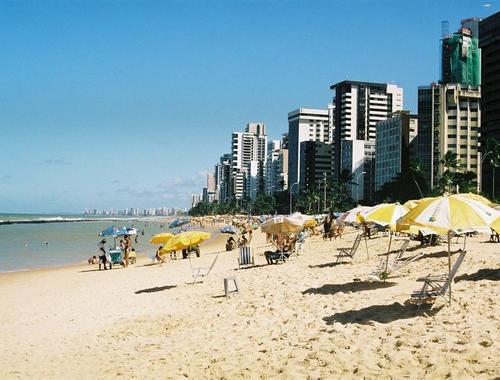 Recife has a population approaching 3.8M, making it the largest city in the Northeast region, and fourth largest city in Brazil. The city is a major port city, and is located where Beberibe River meets the Capibaribe River at the Atlantic Ocean. The delta has many small islands and bridges, giving it the nick name of the "Brazilian Venice." The city is known for all it's beautiful beaches, it's great surfing, and warm ocean waters. The name Recife actually means "reef" in Portuguese, due to the huge offshore reefs that are found along the coast here. Surfing is a big tourist attraction here, along bathing, scuba diving and just geerally lounging on the beautiful white sandy beaches. The city is easily accessible with direct international flights to the US, Europe and Africa. The main airport is Gilberto Freyre/Guararapes International Airport (REC).
Recife has a population approaching 3.8M, making it the largest city in the Northeast region, and fourth largest city in Brazil. The city is a major port city, and is located where Beberibe River meets the Capibaribe River at the Atlantic Ocean. The delta has many small islands and bridges, giving it the nick name of the "Brazilian Venice." The city is known for all it's beautiful beaches, it's great surfing, and warm ocean waters. The name Recife actually means "reef" in Portuguese, due to the huge offshore reefs that are found along the coast here. Surfing is a big tourist attraction here, along bathing, scuba diving and just geerally lounging on the beautiful white sandy beaches. The city is easily accessible with direct international flights to the US, Europe and Africa. The main airport is Gilberto Freyre/Guararapes International Airport (REC).
Salvador
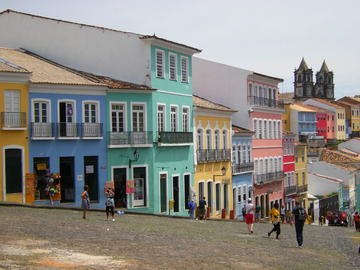 Salvador is another large city, with a population of around 3.7M. The city was the original capital of Brazil and one of the first cities in the "New World". It is known for it's parties, out going people, carnival parades, beaches and beautiful weather. There are over 30 miles of beaches, and many hotels are found along the water front, giving beach front access to their patrons. The waters are calm and ideal for swimming, underwater fishing, and scuba diving. There are also open sea inlets with strong waves, ideal for surfers. Children can great swimming areas where reefs surround some beaches creating natural pools of stone. The local cuisine is spicy and based on seafood, with many dishes using coconuts. The main airport is Deputado Luís Eduardo Magalhães International Airport (SSA).
Salvador is another large city, with a population of around 3.7M. The city was the original capital of Brazil and one of the first cities in the "New World". It is known for it's parties, out going people, carnival parades, beaches and beautiful weather. There are over 30 miles of beaches, and many hotels are found along the water front, giving beach front access to their patrons. The waters are calm and ideal for swimming, underwater fishing, and scuba diving. There are also open sea inlets with strong waves, ideal for surfers. Children can great swimming areas where reefs surround some beaches creating natural pools of stone. The local cuisine is spicy and based on seafood, with many dishes using coconuts. The main airport is Deputado Luís Eduardo Magalhães International Airport (SSA).
Fortaleza
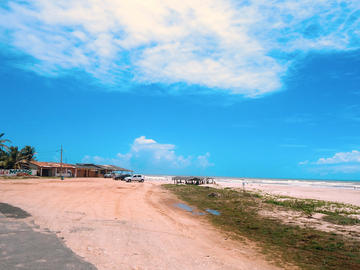 Fortaleza is located in Northeastern Brazil with a population around 3.5M. It is the fifth largest city in Brazil and has one of the highest population densities in Brazil. Due to the proximity of the equator, the city is hot year round, and ideal for beach outings. The cool breeze from the ocean helps keep the city a little more pleasant, but the city is known for it's hot climate. Fortaleza Hotels are situated primarily along the beaches, making the best of the climate and city location. Generally the food in northern Brazil is spicier than the rest of Brazil, and Fortaleza is no different. Beaches, warm water and hot climate make this a great place for tourists. Many European owned resorts have opened up in recent years from expanded European tourism. The main airport is Fortaleza International Airport (FOR).
Fortaleza is located in Northeastern Brazil with a population around 3.5M. It is the fifth largest city in Brazil and has one of the highest population densities in Brazil. Due to the proximity of the equator, the city is hot year round, and ideal for beach outings. The cool breeze from the ocean helps keep the city a little more pleasant, but the city is known for it's hot climate. Fortaleza Hotels are situated primarily along the beaches, making the best of the climate and city location. Generally the food in northern Brazil is spicier than the rest of Brazil, and Fortaleza is no different. Beaches, warm water and hot climate make this a great place for tourists. Many European owned resorts have opened up in recent years from expanded European tourism. The main airport is Fortaleza International Airport (FOR).
Belo Horizonte
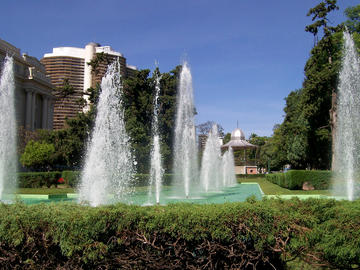 Belo Horizonte is the capital of Minas Gerais and located in southeastern Brazil, with a population of nearly 5.4M. The city was planned in the late 1800's and was built on hills and surrounded by mountains. This is a beautiful inland city, with parks and natural beauty everywhere. The city boasts one of the llargest soccer stadiums in the world, the Mineirão stadium, with many other notable land marks throughout the city. Temperature ranges from roughly 50F to 95F, depending on the time of the year. The main airport is Tancredo Neves/Confins International Airport (CNF).
Belo Horizonte is the capital of Minas Gerais and located in southeastern Brazil, with a population of nearly 5.4M. The city was planned in the late 1800's and was built on hills and surrounded by mountains. This is a beautiful inland city, with parks and natural beauty everywhere. The city boasts one of the llargest soccer stadiums in the world, the Mineirão stadium, with many other notable land marks throughout the city. Temperature ranges from roughly 50F to 95F, depending on the time of the year. The main airport is Tancredo Neves/Confins International Airport (CNF).
Goiânia
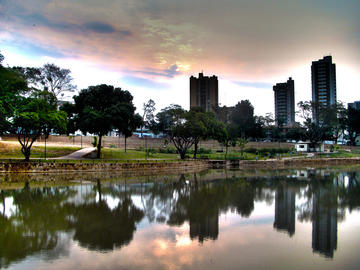 Goiânia is in central Brazil and inland. The city has a population of around 2M and was a planned community. The city boasts the most green area per person in Brazil, making it a beautiful place to visit. Temperatures average around 72F year round, making it a cooler destination than many in Brazil. Agriculture and related activities are the primary economies of the city, but even tourists will find many parks and leisurely activities here. Due to the agricultural nature, and location of the city, it has less tourism than many other cities within Brazil. The main airport is Santa Genoveva National Airport (GYN).
Goiânia is in central Brazil and inland. The city has a population of around 2M and was a planned community. The city boasts the most green area per person in Brazil, making it a beautiful place to visit. Temperatures average around 72F year round, making it a cooler destination than many in Brazil. Agriculture and related activities are the primary economies of the city, but even tourists will find many parks and leisurely activities here. Due to the agricultural nature, and location of the city, it has less tourism than many other cities within Brazil. The main airport is Santa Genoveva National Airport (GYN).
Belém
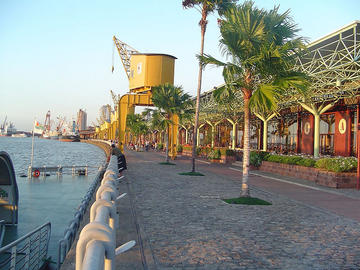 Belém is located on the banks of the Amazon estuary and has a population of around 2M. The climate is a tropical rainforest climate with no dry season, ensuring that any tourist will have at least some rain during their stay for part of the day. Many beautiful parks abound the city, including Rodrigues Alves Wood–Botanic Garden, with it's diverse collection of plants and flowers. It is a 18 acre piece of the Amazon preserved in the city. The city itself has a modern appearance with tree lined streets and modern architecture. The main airport is Belém International Airport (BEL).
Belém is located on the banks of the Amazon estuary and has a population of around 2M. The climate is a tropical rainforest climate with no dry season, ensuring that any tourist will have at least some rain during their stay for part of the day. Many beautiful parks abound the city, including Rodrigues Alves Wood–Botanic Garden, with it's diverse collection of plants and flowers. It is a 18 acre piece of the Amazon preserved in the city. The city itself has a modern appearance with tree lined streets and modern architecture. The main airport is Belém International Airport (BEL).
